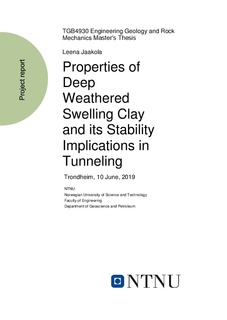| dc.description.abstract | Remains of subtropical deep weathered clay found in fracture and weakness zones in the
bedrock in the Trøndelag area yields poor conditions for tunnel construction and have resulted
in expensive difficulties for such projects. Smectite has a high swelling potential when
hydrated, which can induce swelling pressure and damage the structures it surrounds. This
study was designed as an extension of a previous study performed at NTNU that showed
ambiguity between free swell and swelling pressure measurements. 55 samples exhibiting
swelling behavior were obtained from old SINTEF projects. Swelling minerals were identified
using X-Ray diffraction and the fine particle fraction grain size distribution was measured
using laser diffraction spectroscopy. Swelling potential was quantified using constant volume
oedometer testing and free swell tests. The potential of variance (r2) between mineral content
and maximum swelling pressure was 0.8. Free swell was less correlated with smectite
content, yielding an r2 value of 0.4 and several outliers. Free swell was affected by other
physical parameters in addition to smectite content. Additional tests, which could not be
performed due to limited sample material, are desired to better understand the physical
properties behind each measure of swelling potential. | |
